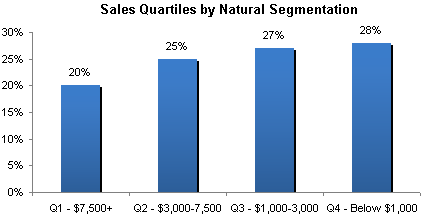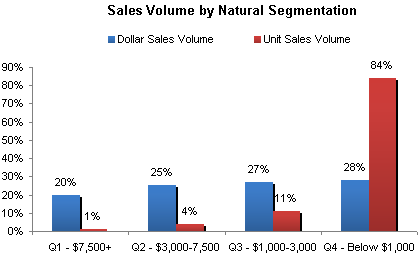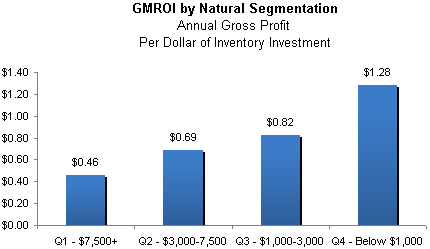IDEX Online Research: Sales By Price Point: Where’s The Business Really Done?
April 15, 10
While a good management information system can provide detailed data about a jeweler’s sales by retail selling price, the segmentation of this data is arguably arbitrary.
For example, at the lower price points, jewelry sales are segmented by $100 increments: $0-100, $100-200, $200-300 and so on. As retail prices rise to $600, the price segments jump to $200: $600-800, $800-1,000 and so on. Above $1,000, the segments rise to a range of $500, with even wider ranges above $5,000.
The reason that jewelers’ sales are segmented in those arbitrary groupings relates to the ability to see a small snapshot by detailed retail price point.
Natural Retail Price Breaks
In an effort to see where a jeweler’s sales actually fall by retail price point, total sales can be segmented by quartile. In other words, jewelers can see “natural” sales segmentation by an array of price points.
The Balance To Buy (BTB) system uses sales quartiles – which segments a jeweler’s sales into quarters – to see where the business is concentrated. According to BTB, the “natural” quartiles shown on the graph below – which were derived from the company’s sample – appear to be nearly universal for specialty jewelers with characteristics similar to the sample: $2 million annual sales and an average ticket in the $700-800 range.
By quartile (roughly 25 percent of sales), the graph below illustrates the “natural quartile” segmentation of sales for this sample of jewelers.

Source: Balance To Buy
While a jeweler’s natural sales segmentation by quartile falls in the ranges shown on the graph above, unit sales by those same quartile segments are quite different. For example, as the graph below illustrates, the top quartile of sales – roughly $7,500 and higher – are generated by only 1 percent of unit sales. Conversely, at the fourth quartile level, 84 percent of unit sales occur below $1,000 retail. This diversity in unit sales versus dollar sales illustrates why inventory levels are so important: if the proper inventory level isn’t in the store, the sales won’t be made.

Source: Balance To Buy
GMROI Is Higher At Lower Price Points
When Gross Margin Return on Investment – for a jeweler, this “Investment” is “inventory” – is calculated, jewelers will find that they make a much better financial return on their lower-priced goods that turn at a fast rate. At the end of the year, they will put more profit dollars in their pockets from lower-price merchandise than from higher-priced goods.
The graph below illustrates the gross profit return based on each dollar invested in inventory, based on a sales segmentation by “natural quartiles.”

Source: Balance To Buy